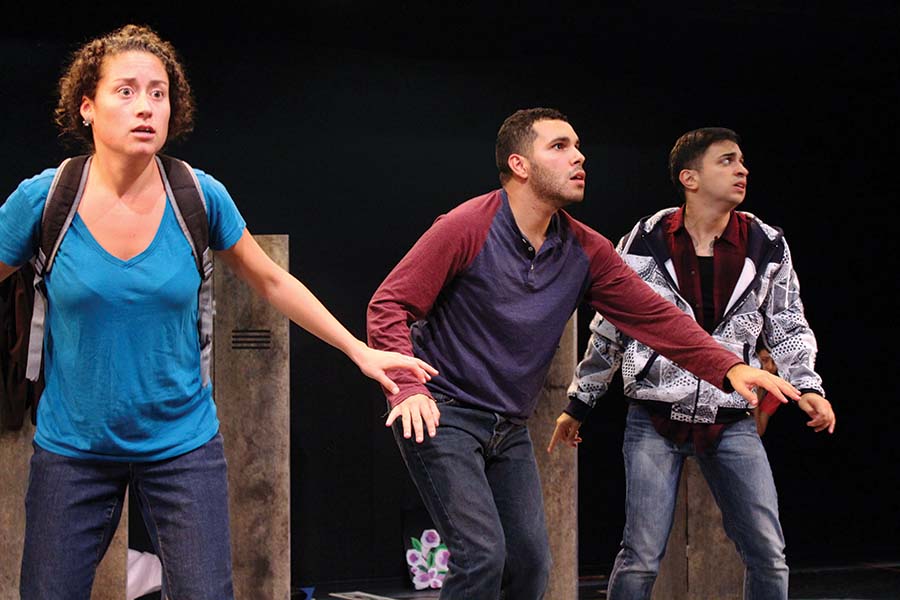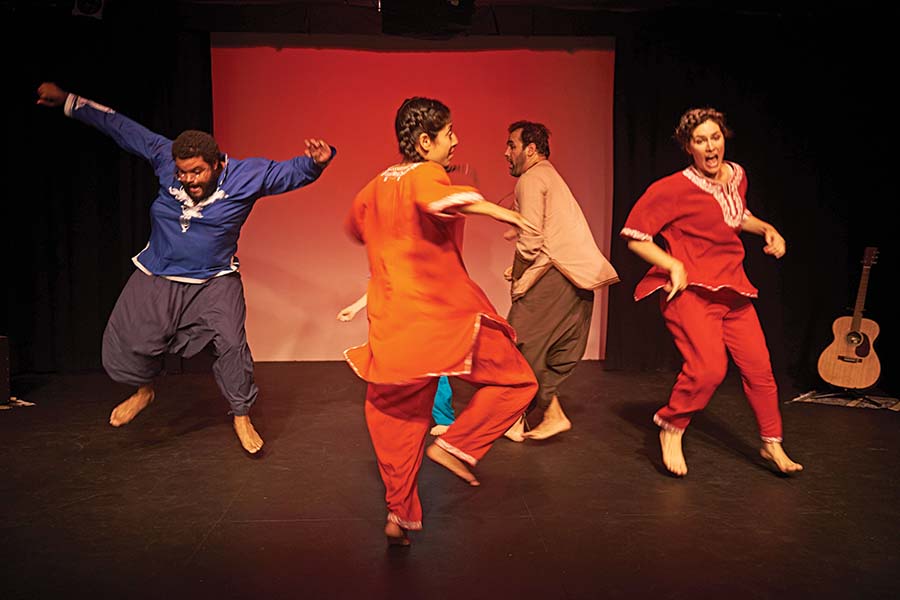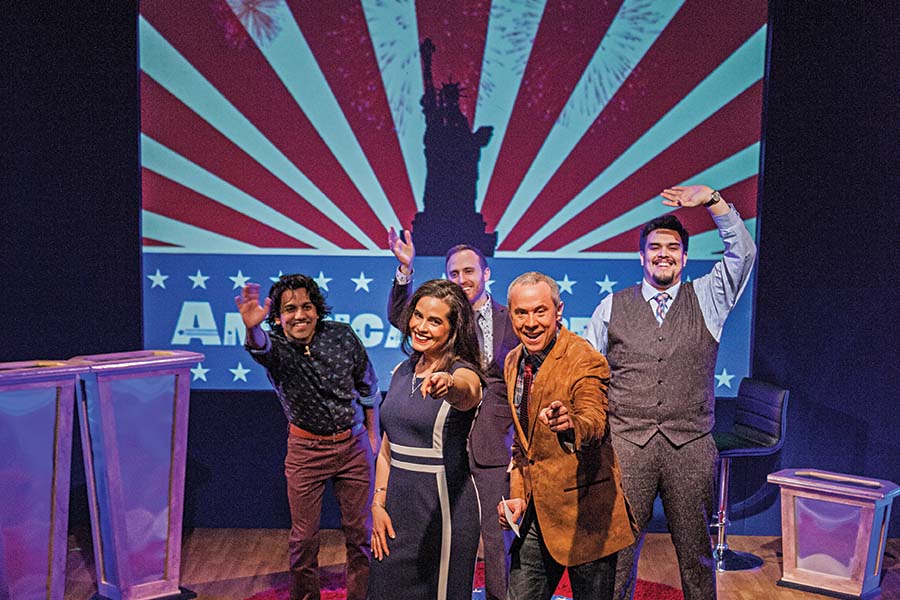Metal detectors. Detailed forms and questionnaires asking for name, religion, country of origin, parents’ countries of origin. Guards pulling certain people out of line for special screening or another go-round with the metal detector.
This wasn’t customs or a checkpoint for asylum seekers. It was the pre-show experience for audiences attending Cleveland Public Theatre’s production of American Dreams, which ran there Feb. 8-March 3.
CPT and other theatres across the country often work with immigrant or refugee populations in their communities on a variety of programs. But that engagement feels all the more urgent now given the anti-immigrant stance and policies of the Trump administration. Theatres are skilled at dramatizing and narrating the stories of our time. But could they do more? Might they provide space and resources to immigrant or refugee members of their communities in a time of fear and misinformation? Can they act as a gathering and knowledge-sharing space for all members of their community: immigrant, refugee, and U.S.-born?
For the creative team of American Dreams, the first step was to reflect a version of the immigrant experience for all audience members, putting those who don’t know it firsthand on an equal footing with those who know it all too well. The pre-show experience with guards profiling some audience members was intentional, said director Tamilla Woodard. “People should witness that as a theatrical device of storytelling,” she said. “We’re doing it as a demonstration, a reflection of the real world.” It’s a visceral way for every audience member to be made aware of how certain people are treated every day.
After the pre-show gauntlet, American Dreams imagined a version of the U.S. where citizenship is sought and won on a televised game show, with the attendees at each performance serving as the live studio audience. They were called upon throughout five rounds to assist three contestants in answering questions about American tastes, history, and politics; to provide thumbs-up or thumbs-down responses to contestants’ answers; and to ultimately vote on a winner: the person they wanted to be their new neighbor.
Isam Zaiem, an American Dreams audience member and himself an immigrant and civil rights activist, confessed that he didn’t realize how difficult it would be to make a decision. “How do you choose which of the three applicants should have the opportunity to become an American citizen? How do you make such a life-changing decision when every applicant is deserving of that chance?” he wondered rhetorically.
That interactivity and indeterminacy is what initially attracted CPT executive artistic director Raymond Bobgan to the project. “There’s something about the audience participation that makes the audience complicit in a way that we already are but don’t recognize,” he said. “Every time we vote, every time we engage, how we respond to Facebook posts, how we give our money when we’re donating—all of these are things that we’re doing that make us complicit in our foreign policy. What this play did was say, ‘We’re going to make that complicity really explicit.’”
The main creator of this devised piece was Leila Buck, with support from Woodard and an ensemble of actors who, in creating their characters, drew on personal experiences as well as in-depth interviews with immigrants in the Cleveland area. Born to an American father and a Lebanese mother, Buck spent her youth living in countries in the Arab world, a result of her father’s work with the foreign service. There she experienced “both the privilege of being American and being able to cross borders, and also knowing some of the people who are responsible for deciding who gets across those borders,” she said.
Through her personal and professional experiences, though, she’s met people “for whom it is challenging sometimes to be seen as a trustworthy person to be let into our country.” American Dreams was created with that thought in mind. “How do you create a space within the theatre for people to be able to reflect within themselves on how we decide who we trust, who we let in?” Buck said.
Isabel Galvez, an immigrant and a Cleveland resident of 23 years, is an active member of CPT’s community, providing translation services and serving on its informal steering committee. Galvez responded to particular moments in American Dreams differently than the U.S.-born audience members—she laughed at one quiz question about the Constitution, because she recognized the quotation as false, while U.S.-born audience members were silent. Ultimately, she felt encouraged by the experience.
“Things like this have a big potential to educate American citizens,” she said. “Unfortunately, with all these immigration issues that we live and breathe day in and day out, you start to understand that many people take positions and many times are against immigrants.”

Imagination Stage in Bethesda, Md., was after a similar understanding when they launched the ¡Óyeme! program four years ago. Responding to an influx into the region of unaccompanied minors from Central America, Imagination Stage reached out to the minors and invited them to make a play about their experiences. The theatre company commissioned playwright Miriam Gonzales to write the play, and enlisted a government partner in Health and Human Services, who identified youth who might benefit from the program.
Imagination Stage always made sure to have social workers on hand during program sessions, as many of these young people experienced trauma in their home countries and in their journey to the United States. ¡Óyeme! offered a safe space for the youth to share their stories, learn about theatre, and create a bilingual play called Óyeme the Beautiful, which has now toured schools throughout the area, reaching students who have made the same journey and those who haven’t.
After each school performance, a teaching artist leads students through activities, one of which asks them to write a letter home in the voice of one of the play’s characters. It’s here that Imagination Stage staff have seen evidence of the play’s power to build empathy. One student wrote, ventriloquizing an immigrant: “I’ve come to the USA. I miss you all. I have been making lots of friends. I’m hopeful that one day you’ll be able to come join me. Everything here is so beautiful. I’m safe here.”
Educators are often pleasantly surprised by the play’s power to engage some of their more unruly students. An ESOL teacher, Laura Desobry, wrote to Imagination Stage’s director of education, Joanne Seelig, after a performance of Óyeme the Beautiful to say, “You had the full attention of quite a few difficult newcomer students, who literally run around the halls when they should be sitting in class. It’s been a long time since I have seen them so calm and still.”
She added that two other students who had been struggling with their cultural identity “were beaming with pride while explaining components of the play and the journey to their classmates. I think they took a lot of pride in being able to answer the many questions posed by their non-Spanish-speaking classmates.” Seeing their experiences reflected and hearing their language onstage was affirming.
Another teacher, Ludmilla DeBord, confirmed the play’s power for her students: “It affected deeply my ESOL kiddos as we discussed it in all three of my classes today. They had a lot to say and share, and I could see that they understood and took to heart a lot of important lessons from the play.”
Teaching artist Taous Claire Khazem also undertook a play-creation project, though on a smaller scale, with a youth summer program organized by Mixed Blood Theatre in Minneapolis. She asked each participant to go home and ask an elder to share a folktale. Khazem, whose father is from Algeria, has long been captivated by folktales and the oral traditions of her father’s country of origin.
“It’s really important to not lose those elements of culture,” she said. “Those stories hold wisdom. They held a purpose. They’re there to teach us something, whether it’s a cautionary tale or a lesson to learn that I think are still relevant now.”
By asking the youth to talk with their elders about folktales, Khazem hoped to bridge the gap between generations created by distance and time, and to reinforce the value and beauty of oral tradition. After hearing everyone’s folktales, the group chose one of them to turn into a short play. “Most of them had never been onstage before,” Khazem said. “Before the performance, they were really nervous. But they really pulled it off. I think they felt so proud of themselves that they were able to sing a song, move their bodies, tell a story in front of a group of people—an immense sense of pride in sharing who they were.”
Khazem’s work is one part of larger efforts by Mixed Blood to build relationships with members of their surrounding Cedar-Riverside community. Thirty-seven percent of Cedar-Riverside residents were born outside the United States, and a little more than 50 percent speak a language other than English.
“It’s surprising, but also not surprising, that the residents still don’t really know who we are as an organization,” said Keri Clifton, Mixed Blood’s chief engagement officer. “We’ve been operating in the neighborhood for more than 40 years. Residents are still unsure of who we are and what we do. As the theatre has moved away from trying to engage them through our mainstage productions only, the relationship with residents has started to change. To be effective, we have to be more than just a theatre.”
To that end, Mixed Blood’s community organizer, Sisco Omar, convenes a neighborhood advisory council, and the theatre regularly opens its space for community movie or conversation nights. They’ve also recently received a grant to embark on a project focused on health and storytelling with community partners. These efforts happen in parallel to Mixed Blood’s theatrical season, showcasing how a theatre can be more than a place to present plays and work with non-theatre organizations to enrich their communities.

Partners are key, it seems, in reaching out to immigrant and refugee audiences who might be otherwise unfamiliar with a theatre’s work. Seelig found their project partners invaluable in working with the students in the ¡Óyeme! program. “We’re arts educators, not therapists,” she said, honoring the fact that many of the students may be struggling with issues that Imagination Stage is not professionally equipped to handle. “That’s where we rely on our partners really heavily.”
Cleveland Public Theatre has long-standing partnerships with several organizations throughout the city. An invaluable partner in their work with immigrants and refugees has been Global Cleveland, an organization “founded on this idea that immigrants and migrants can have a positive and beneficial impact on our economy,” Bobgan explained. “And, actually, for Cleveland to be successful and continue the incredible comeback it’s in, we need immigrants. We need new stories. We want new cultures. We need their expertise, their skills, and their passion.”
Besides assisting in organizing post-show panels for American Dreams, Global Cleveland has connected the theatre with students at the Thomas Jefferson International Newcomers Academy, who represent at least eight different countries. CPT has also created a Latinx theatre ensemble, Teatro Publico de Cleveland, and is in the planning and development stages of an ensemble for an Arabic-language theatre. Teatro Publico’s productions have featured members of the community, many of whom had never been onstage before or who hadn’t acted in a long time. With this ensemble, CPT is providing an opportunity for immigrants and Spanish speakers to celebrate their cultures. In an early Teatro Publico production, a character sang a song in Spanish about Puerto Rico, Bobgan recalled. Many of the audience members stood and joined in.
As with any programming, there are potential hazards with theatres seeking to engage immigrant and refugee populations in their communities. Khazem admits there’s the risk in any work with immigrant or refugee communities that the participants or the work they create might be flattened, reduced, or fall into the realm of stereotype. She always works to subvert or complicate that. “There’s not one kind of Muslim; there’s not one kind of immigrant from the African continent,” she stressed. “We’re all complicated people with complicated stories and histories.”
Mixed Blood’s Clifton expressed a practical concern: Some staff turnover at the theatre over the past two years has interrupted the formation of long-term relationships with neighborhood residents. “Right now, the most important thing for us to work on is building trust and consistency with the work that we’re doing,” Clifton said. “We want to build out our programming and our work so that no matter what happens with us as an organization we will be able to maintain trust and consistency for the residents and organizations that we work alongside.”
Bobgan, too, highlighted the importance of relationships that are give-and-take. These efforts aren’t about going into a community and only asking what they want, or only inviting them to one production. “You have to approach it like you’re approaching any relationship with somebody you may or may not have familiarity with,” he said. “I think that is the best way to approach work with refugees is saying from the beginning, ‘I have a bunch of skills. What skills do you have? Are you interested in learning some of my skills?’”
Those kinds of conversations need to happen over and over and well in advance of creating programming or a production meant to engage immigrant and refugee audiences. Many of the artists and staff who do this work recommended being clear about expectations with all involved parties. “If you want to work with a refugee community, you have to have the intention from the beginning that you hope this will be a long-term relationship,” Bobgan said. “If not, you have to make that clear from the beginning. That’s okay, as long as you’re clear about that.”
Khazem stressed the importance of not making assumptions. “If I’m working with a community I don’t know, I shouldn’t go in like, ‘I know everything about you,’” she said. “I have more to learn than the people I’m working with. It’s important that I offer what I know, but I’m always open to learning new things and having my own assumptions challenged.”
Galvez, the volunteer working with CPT, has been very impressed with the work the theatre has done reaching out to the diverse communities of Cleveland. “You work to sustain yourself and have a job and a home, but you also need to cultivate another level that is so important for human beings,” she said. “To be able to have a little bit of music in your life, have a little bit of art in your life, have a little appreciation of beauty and artistic expression—CPT is allowing more people to have that expression.”
These and other theatres across the country are finding new ways to open their doors, engage with their neighborhoods, and make theatre more accessible—and audiences are responding. It’s no longer enough (if it ever really was) for a theatre to mail out a season brochure and wait for tickets to sell. As Clifton said, theatres must be more than theatres if they really want to engage everyone in their community. This is natural. The theatre has always been a meeting place to exchange ideas, encounter new worlds, ask complicated questions, and, above all, experience art. And while our nation’s leadership may seem dead set on showing its less inviting side to the world, the theatre can still be a place where all are welcome.
Theresa J. Beckhusen is a writer and editor based in the Twin Cities.


